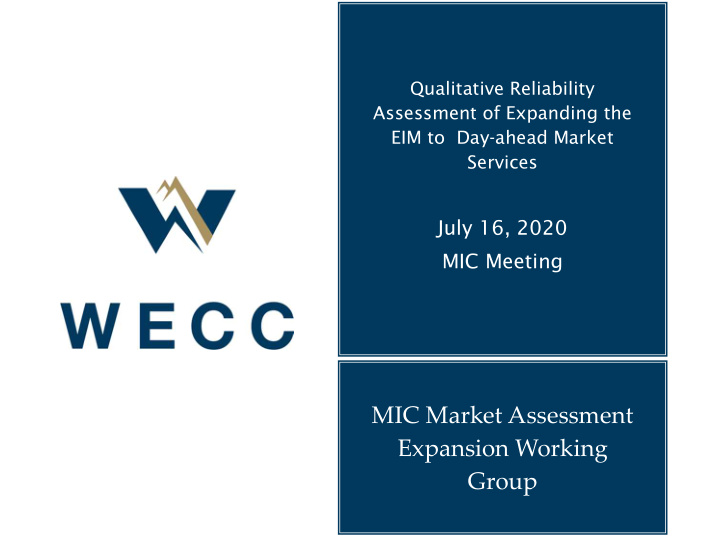



Qualitative Reliability Assessment of Expanding the EIM to Day-ahead Market Services July 16, 2020 MIC Meeting MIC Market Assessment Expansion Working Group
Overview of Presentation ▪ Overview, Key Findings and Next Steps • Alaine Ginocchio, WIRAB ▪ Communications Plan • Jordan White, Vice President of Strategic Engagement & Deputy General Counsel, WECC • Victoria Ravenscroft, Senior Policy & External Affairs Manager, WECC 2
Overview of Report ▪ A qualitative assessment of potential reliability impacts from expanding EIM to include day- ahead market services. • Does not address potential economic benefits or estimate cost savings • Based on assumptions for the market design. (See appendix slide) • Full presentation at last MIC meeting 3
Overview of Report ▪ Goals of Report • Describes key changes in day-ahead processes and the potential impact these changes could have on reliability • Provides clear understanding of core operations and concepts in the two markets ▪ Accessible to WECC Board of Directors & state & provincial policymakers and regulators 4
Overview of Report ▪ Evaluating impact of DAMS addition only • EIM impacts have been evaluated • DAMS impact on real-time operations included ▪ What we are comparing • Day-ahead (DA) operations now outside of CAISO: bilateral market paradigm • Real-time operations: EIM • DA operations in an EIM + DAMS: CAISO’s current DA operations with some adjustments 5
MIC Working Group Organization Robert Follini Avista Andrew Meyers Bonneville Power Administration Darren Lamb California ISO Jamie Austin PacifiCorp Charles Faust WAPA, Sierra Nevada Region Jason Smith Xcel Energy Angela Amos FERC, OEMR Ben Foster FERC, OEPI Dillon Kolkmann FERC, OEPI Jomo Richardson FERC, OER Monica Taba FERC, OER Layne Brown WECC Jennifer Gardner / Western Resource Advocates Vijay Satyal Alaine Ginocchio WIRAB 6
Overview of Report Explored significant changes and their impact on reliability. Evaluated in five areas: 1. General day-ahead operations 2. Transmission congestion management 3. Seams 4. Ancillary services 5. Contingency analysis Themes emerged. 7
Reliability Benefits: Themes ▪ Improved coordination across a broader geographic footprint ▪ Utilizing an advanced set of tools in the day-ahead time frame and applying them uniformly over multiple BAs. • Improved wide-area view by the market operator for use in developing the day-ahead commitment • Improved response to variability • Improved congestion management and relaxed impact of seams ▪ Better positioning and set-up for real-time operations 8
Potential Risks The following challenges could become risks: ▪ Additional complexity for transmission operations: new challenges managing seams between organized markets and operating closer to System Operating Limits (SOLs) ▪ Reduction of liquidity in the bilateral trading market ▪ Voluntary transmission provision: there may be incentives to retain transmission capacity ▪ Potential challenges in gas – electric coordination 9
Recommendations to WECC ▪ Continue to monitor the development of the market design with emphasis on: • The design for transmission operations including coordination plans and agreements between BA’s and between markets. • The design for the resource sufficiency evaluation. • How day-ahead market timelines could impact gas scheduling including business practices and tools that could be employed to offset potential reliability impacts. 10
Recommendations ▪ Continue to monitor the effectiveness of reserve requirements: reduced amount of reserves carried by BAs when day-ahead market operations begin (because of market efficiencies) could potentially require re- evaluation of reserve requirements. 11
Report Overview Questions 12
Next Steps ▪ Posting Final Draft of Report Early August ▪ Communications and Dissemination Plan 13
Communications Plan ▪ Jordan White, Vice President of Strategic Engagement & Deputy General Counsel, WECC ▪ Victoria Ravenscroft, Senior Policy & External Affairs Manager, WECC 14
Milestones to Completion Post final report Finalize WECC Post for Launch MIC draft internal MIC comm. approval report review approval plan July August 15
Communication Plan Standard activities ▪ Post on MIC committee page ▪ Announce in WECC weekly ▪ Email committee Additional activities ▪ Announcement section, homepage, WECC.org ▪ Social media campaign (Twitter/LinkedIn) ▪ Expanded email distribution • Standing committees • Others? 16
Communications Plan Questions / Discussion 17
Contact: Alaine Ginocchio, WIRAB: aginocchio@westernenergyboard.org Robert Follini, Avista: Robert.Follini@avistacorp.com 18
Assumptions for the Market Design What do we mean by “EIM + DAMS”? Core Assumptions • BAA boundaries and NERC-related compliance responsibilities will remain intact. • Control of transmission facilities will not be transferred to a market operator. • Integrated resource planning, resource adequacy procurement, and transmission planning and investment decisions will remain with each BA (and state/local regulatory authority). • DAMS will be a layer on top of the EIM, using CAISO’s market services as the model Transmission • Complement the contract reservation regime • Sufficient incentives to make enough transmission available to address reliability requirements • No assumptions about design 19
Assumptions for the Market Design • Participation: BAs, voluntary, no DAMS stand-alone • Geographic Footprint: All EIM Entities (see figure) • CAISO’s Market Analysis Engine: SCUC, FNM and flow-based modeling, LMP • Ancillary Services: Offered as an option • Resource Sufficiency: RS evaluation in the day-ahead, no assumptions about design of test • Other Markets: DAMS will operate along-side the day-ahead bilateral market; no centralized capacity market 20
CAISO’s Market Analysis Engine
Recommend
More recommend